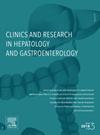Specific association and independent predictive value of HBV RNA in the disease progression of hepatitis B with low-level viremia
IF 2.4
4区 医学
Q2 GASTROENTEROLOGY & HEPATOLOGY
Clinics and research in hepatology and gastroenterology
Pub Date : 2025-07-01
DOI:10.1016/j.clinre.2025.102648
引用次数: 0
Abstract
Background and objective(s)
HBV RNA serve as a downstream transcriptional product of cccDNA within the liver. This study is the first to investigate the diagnostic significance of serum HBV RNA in HBV low-level viremia (LLV) patients, elucidating the interrelationships among serum HBV RNA, HBV DNA, and HBsAg.
Methods
A cohort of 514 HBV LLV patients was collected from The Second Hospital of Nanjing and divided into four groups: asymptomatic HBV carriers (ASC), chronic hepatitis B (CHB), liver cirrhosis (LC), and hepatocellular carcinoma (HCC). All were tested and analyzed for HBV RNA, HBV DNA, HBsAg, HBeAg, and liver function.
Results
serum pathological indicators showed statistically significant differences included RNA, DNA, HBsAg, HBeAg-positive, TBIL, DBIL, IBIL, TP, ALB, ALT, AST, ALP, GGT (P < 0.001), and HBeAg-negative (P = 0.019). Both HBV RNA and HBV DNA were positively correlated with HBsAg (r = 0.405, P < 0.001; r = 0.198, P < 0.001). The correlation between HBV RNA and HBsAg was stronger than that between HBV DNA and HBsAg, and this difference became more pronounced after stratifying patients based on disease progression stages. This was also the case in different HBeAg states. We further conducted multivariate logistic regression analysis, and the results showed that RNA had strong statistical significance in the ASC and CHB groups (P < 0.001).
Conclusions
Monitoring HBV RNA levels holds certain value in assessing antiviral therapy efficacy and predicting disease progression stages and clinical outcomes in HBV LLV patients.
HBV RNA在乙型肝炎伴低水平病毒血症的疾病进展中的特异性关联和独立预测价值
背景和目的:HBV RNA在肝脏内作为cccDNA的下游转录产物。本研究首次探讨了血清HBV RNA在HBV低水平病毒血症(LLV)患者中的诊断意义,阐明了血清HBV RNA、HBV DNA和HBsAg之间的相互关系。方法:收集南京第二医院514例HBV LLV患者,将其分为无症状HBV携带者(ASC)、慢性乙型肝炎(CHB)、肝硬化(LC)和肝细胞癌(HCC) 4组。所有患者均进行了HBV RNA、HBV DNA、HBsAg、HBeAg和肝功能的检测和分析。结果:血清病理指标RNA、DNA、HBsAg、hbeag阳性、TBIL、DBIL、IBIL、TP、ALB、ALT、AST、ALP、GGT、hbeag阴性差异有统计学意义(P = 0.019)。HBV RNA、HBV DNA与HBsAg均呈正相关(r = 0.405,P < 0.001;r = 0.198,P < 0.001)。HBV RNA和HBsAg之间的相关性强于HBV DNA和HBsAg之间的相关性,并且在根据疾病进展阶段对患者进行分层后,这种差异变得更加明显。这在不同的HBeAg州也是如此。我们进一步进行多因素logistic回归分析,结果显示RNA在ASC组和CHB组具有较强的统计学意义(P < 0.001)。结论:监测HBV RNA水平对评估HBV LLV患者抗病毒治疗效果、预测疾病进展阶段及临床结局具有一定价值。
本文章由计算机程序翻译,如有差异,请以英文原文为准。
求助全文
约1分钟内获得全文
求助全文
来源期刊

Clinics and research in hepatology and gastroenterology
GASTROENTEROLOGY & HEPATOLOGY-
CiteScore
4.30
自引率
3.70%
发文量
198
审稿时长
42 days
期刊介绍:
Clinics and Research in Hepatology and Gastroenterology publishes high-quality original research papers in the field of hepatology and gastroenterology. The editors put the accent on rapid communication of new research and clinical developments and so called "hot topic" issues. Following a clear Editorial line, besides original articles and case reports, each issue features editorials, commentaries and reviews. The journal encourages research and discussion between all those involved in the specialty on an international level. All articles are peer reviewed by international experts, the articles in press are online and indexed in the international databases (Current Contents, Pubmed, Scopus, Science Direct).
Clinics and Research in Hepatology and Gastroenterology is a subscription journal (with optional open access), which allows you to publish your research without any cost to you (unless you proactively chose the open access option). Your article will be available to all researchers around the globe whose institution has a subscription to the journal.
 求助内容:
求助内容: 应助结果提醒方式:
应助结果提醒方式:


